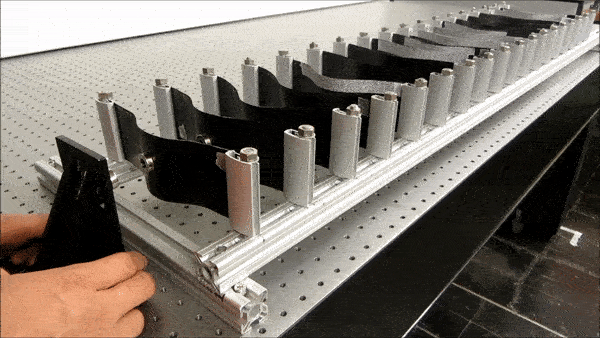Ride the wave: soliton resonance may enable mechanical energy harvesting

“A metamaterial basically means combining two different materials into a new structure with its own unique properties,” said Andres Arrieta, assistant professor of mechanical engineering. Arrieta’s previous research with metamaterials focused on their static bistable states: origami that folds like an insect wing; shape-changing furniture based on the Venus flytrap; and dimpled circles that store energy like a mechanical battery. But this research examines a more dynamic aspect of metamaterials: how waves of energy propagate through them.
“When waves propagate, they travel through a medium,” said Arrieta. “Think of ripples on a pond, or hearing sound waves that travel through the air, or feeling the vibrations of an earthquake rumble through the ground. The density of the material dictates the frequency of the wave. By using these metamaterials as our medium, we can customize how those waves travel.”
Arrieta’s experiment involved two parallel beams, connected by a series of flexible ladder-like struts. A shaker device pushed the struts in and out, creating wave-like motion in one direction; the struts’ off-center locations caused the entire beam to sway side-to-side in the perpendicular direction. By comparing the frequency of the beam’s side-to-side movement with the frequency of the struts’ in-and-out movement, they identified a solitonic resonance.
Solitons (also called “solitary waves” or “transition waves”) are waves that don’t lose energy or shape as they travel – in effect, acting more like particles than traditional waves. It’s the principle behind falling dominoes; a gentle push to one domino triggers a wave that travels a consistent speed down the line, so long as the dominoes are all the same distance apart. Arrieta’s experiment demonstrated how his metamaterials harness this solitonic resonance to convert any frequency content at the input stage, to a distinct frequency at the output stage. "It's like a laser, which takes the multiple frequencies of white light and converts them to a focused stream of one single frequency," said Arrieta, "except we are controlling the output frequency with the physical properties of these metamaterials."
The research has been published in Physical Review Letters.
“This is one of the big issues with energy harvesting,” said Arrieta. “The vibrations that those cars or people produce tend to be at a very low frequency, and to match that frequency you need a big heavy mass, which makes the whole process impractical. But with these metamaterials, we can create a physical medium that converts these specific frequencies into frequencies that are useful.”
Arrieta had previously published research proposing the use of bistable materials for energy harvesting, but lacked the mechanism for frequency conversion. “Now that we’ve shown the potential of these metamaterials,” said Arrieta, “we’re excited to explore the opportunities of energy harvesting and beyond.”
Writer: Jared Pike, jaredpike@purdue.edu, 765-496-0374
Source: Andres Arrieta, arrieta@purdue.edu
This work was supported by the National Science Foundation under Grant No. CMMI-1935137.
Extreme Frequency Conversion from Soliton Resonant Interactions
Myungwon Hwang and Andres F. Arrieta
https://doi.org/10.1103/PhysRevLett.126.073902
ABSTRACT: We present a metastructure architecture with a bistable microstructure that enables extreme broadband frequency conversion. We use numerical and experimental tools to unveil the relationship between input excitations at the unit cell level and output responses at the macrostructural level. We identify soliton-lattice mode resonances resulting in input-independent energy transfer into desired metabeam vibration modes as long as transition waves are triggered within the metastructure. We observe both low-to-high and high-to-low incommensurate frequency interactions in the metabeams, thus enabling energy exchange between bands 2 orders of magnitude apart. This behavior generalizes fluxon-cavity mode resonance in super-conducting electronics, providing a general method to extreme frequency conversion in mechanics. Importantly, the introduced architecture allows for expanding the metamaterials design paradigm by fundamentally breaking the dependence of macroscopic dynamics on the unit cell properties. The resulting input-independent nature implies potential applications in broadband frequency regulation and energy transduction.
